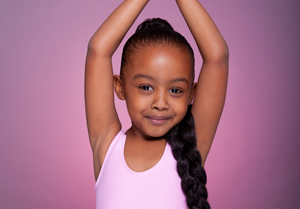Starting Pointe Classes for the First Time
Comments Off on Starting Pointe Classes for the First TimeOnce a girl has begun studying ballet, the day arrives when she becomes very excited (as well as impatient) to begin pointe work. Before a student begins dancing on pointe however, there are a few factors that need to be considered in order to ensure a safe and positive outcome. Dancing on pointe is a big step forward in a student’s training and it is important to be certain that she has the technique, strength and physical development necessary to be successful.
Before beginning actual pointe work, many studios offer “pre-pointe” classes with strengthening exercises for the muscles in the ankles and feet.
While students (and parents) may push to start pointe after a year or two of ballet, the decision must be left to a teacher. Students may think it is unfair and feel upset if classmates/friends begin pointe and they do not, so it is important to remember that the teacher is acting in the best interest of the child and is doing what is best for the development of each dancer.
Here are some factors a teacher reviews prior to pointe work:
- Age; it is highly recommended that students be at least 11 years old before beginning pointe.
- Technique; Dancers should have a solid foundation in ballet training (typically a minimum of three years of study).
- Range of motion in the ankles; this can be checked in an echappe to second position. The feet should extend into a straight line with the shin (if you line up a pencil with the top of a student’s arch it should also touch the shin).
- Physical maturity of the dancer; many studios require a doctor’s note prior to pointe (to check the growth plate openings in a student’s toes and feet).
- The student’s alignment and the strength of the “core” muscles to maintain posture.
Before beginning actual pointe work, many studios offer “pre-pointe” classes with strengthening exercises for the muscles in the ankles and feet. Students can also work on foot articulation by practicing gripping and lifting pencils or marbles with their toes as well as ankle strengthening with elastic exercise bands. Working on tendus and degages is very important in preparing for pointe work. Pre-pointe classes can be taxing on young dancers’ calf muscles and ankles so it is important they have attained a strong technique before beginning these classes.
When students begin dancing on pointe they are often subject to blisters, corns and bruised toenails- no fun! It is important that a shoe specialist fit a dancer for her shoes as they will fit much differently than other types of shoes. When being fitted, a student should wear whatever padding (i.e. lambs wool, ouch pouches, medical tape) she plans to use when dancing to ensure the shoe still fits properly. Most dancers develop callouses within the first months of pointe and the blisters subside.
Students must also be taught how to correctly sew elastic and ribbon onto shoes and how to tie the ribbons. Ribbon tied too loosely will not provide the support needed, while ribbon tied too tightly can cut off circulation. Once a dancer has been instructed in all these points, the pointe work can begin!
 Performing Opportunities. Most schools will have an end of the year show and possibly more throughout the year. Performing on stage is the end result of taking classes. Without school performances, it would be like enrolling and practicing baseball every week, but never playing a game! The ability and exposure at a young age can benefit your child in a multitude of ways in the future, even outside of ballet. It takes a lot of courage to go out in front of a large crowd and doing so can help build confidence.
Performing Opportunities. Most schools will have an end of the year show and possibly more throughout the year. Performing on stage is the end result of taking classes. Without school performances, it would be like enrolling and practicing baseball every week, but never playing a game! The ability and exposure at a young age can benefit your child in a multitude of ways in the future, even outside of ballet. It takes a lot of courage to go out in front of a large crowd and doing so can help build confidence.